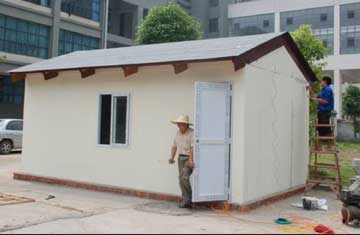A professor on sabbatical in China has created a prototype of a sturdy, quick-to-build bamboo house designed to help the vast number of people made homeless by the Sichuan earthquake.
Prof Yan Xiao, an expert in structural design and retrofit in the Sonny Astani Department of Civil and Environmental Engineering at the University of Southern California, has been experimenting with bamboo-based materials for highly demanding structural uses in China's Hunan province, and recently built the world's first bamboo truck bridge there, in the city of Leiyang.
He went to nearby Sichuan province the day after the Sichuan earthquake hit and then returned to the Chinese Ministry of Education Key Laboratory at Hunan University, where he immediately sett to work on a housing solution.
The prototype bamboo quake relief house he built in less than two weeks adopted a modular design that can be adjusted according to specific family needs.
'The modular units are connected by bolts and are easy to manufacture and assemble,' said Xiao. 'Four to six workers can assemble a 22.3m2 house in about four hours. The majority of the structural materials used are processed bamboo veneer sheets, a kind of bamboo fibre composite.'
Xiao said that interior detailing is similar to the wood frame houses in the North America, noting that the design conforms to current US building codes requirements for quake resistance.
'The relief house contains two windows, fans, locations for LPG stove or bath unit, satisfying basic needs for shelter for a family of up to four,' he said.

Xiao said that the first batch of twenty units, donated by Hunan University, will be sent to the affected area soon, adding that the cost per square metre of the units, which are manufactured in China, is about 350 to 500RMB, or $50-70.
'Unlike tents, the bamboo quake relief house is insulated for heat and sound, is fireproof, allows residents to secure their possession, and is more durable,' Xiao said. 'It is also inexpensive compared with temporary houses using other traditional materials, such as light gauged steel. Finally, bamboo is a green and sustainable construction material, widely available in China and other Asian countries.'
The Chinese government estimates that more than one million relief temporary housing units are needed in Sichuan.




Swiss geoengineering start-up targets methane removal
No mention whatsoever about the effect of increased methane levels/iron chloride in the ocean on the pH and chemical properties of the ocean - are we...